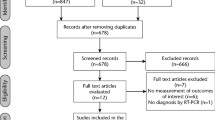Abstract
Data sources Non-systematically compiled data.
Study selection No formal in- or exclusion criteria.
Data extraction and synthesis Not described; narrative synthesis.
Results SARS-CoV-2 is near ubiquitously present in saliva samples of infected individuals; the saliva is hence a potential source for infection for both dental professionals and dental patients given possible transmission routes involving saliva-containing aerosol, splatter or droplets for COVID-19.
Conclusions Dental professionals should be aware of that transmission route and should undertake protective measures accordingly.
Similar content being viewed by others
A Commentary on
Li Y, Ren B, Peng X et al.
Saliva is a non-negligible factor in the spread of COVID-19. Mol Oral Microbiol 2020; DOI: 10.1111/omi.12289.

GRADE rating
Commentary
This narrative review, building on limited original data from the authors' laboratory and largely being borrowed from other reports on corona and other viruses, sums up the relevance of saliva and oral (specifically salivary) epithelia in Covid-19 (SARS-CoV-2) infection and transmission. There are a number of relevant points to highlight:
• Early target cells for SARS-CoV (and other virus) infections are those which harbour angiotensin-converting enzyme 2 (ACE2), for example in the salivary gland duct
• These cells may be both targets and sources for infections like SARS-CoV-2
• Also, saliva was found to harbour an especially high number of viruses (more than found in the throat, for example) in nearly all infected patients, highlighting the risk of oral transmission of SARS-CoV-2
• It can be hypothesised that dental clinicians in close contact with patients and their saliva are at high risk of splatter, droplet and aerosol mediated infection (for example, via their skin, their mucosa, their eyes or via inhalation)
Precautions in dental practices are required (and outlined in the article) to reduce the risk of saliva-mediated SARS-CoV-2 transmission.
Overall, the presented findings are largely located on a very low level of evidence, oftentimes not supported by any direct data, but indirect assumptions and imputations or experience. Notably, the indicated relevance of saliva and the associated risks for the dentists as an infection target and the dental office as a high-risk spreading zone have so far not been unambiguously confirmed. That, however, might also be an indication of how practised in infection control dentists and other dental professionals are. All are highly experienced in reducing cross infection risks.
This review succinctly informs practitioners as to the relevance of saliva and oral epithelial cells (for example, those carrying ACE-2) for SARS-CoV-2 infection and transmission. It further acts as a warning and highlights which strategies dental professionals should implement to reduce these risks. As commonly found these days, the level of evidence for all such recommendations is low and the supporting data extremely sparse: We have to 'drive on sight' with this, and evidence at a very low level is unfortunately largely all we have, at present. Consciously and critically applying that evidence is where evidence-based-practice has a major role within the current crisis.
Author information
Authors and Affiliations
Rights and permissions
About this article
Cite this article
Schwendicke, F. Saliva is a potential source of Covid-19, and appropriate protection measures should be applied in dental practice. Evid Based Dent 21, 62 (2020). https://doi.org/10.1038/s41432-020-0101-y
Published:
Issue Date:
DOI: https://doi.org/10.1038/s41432-020-0101-y



